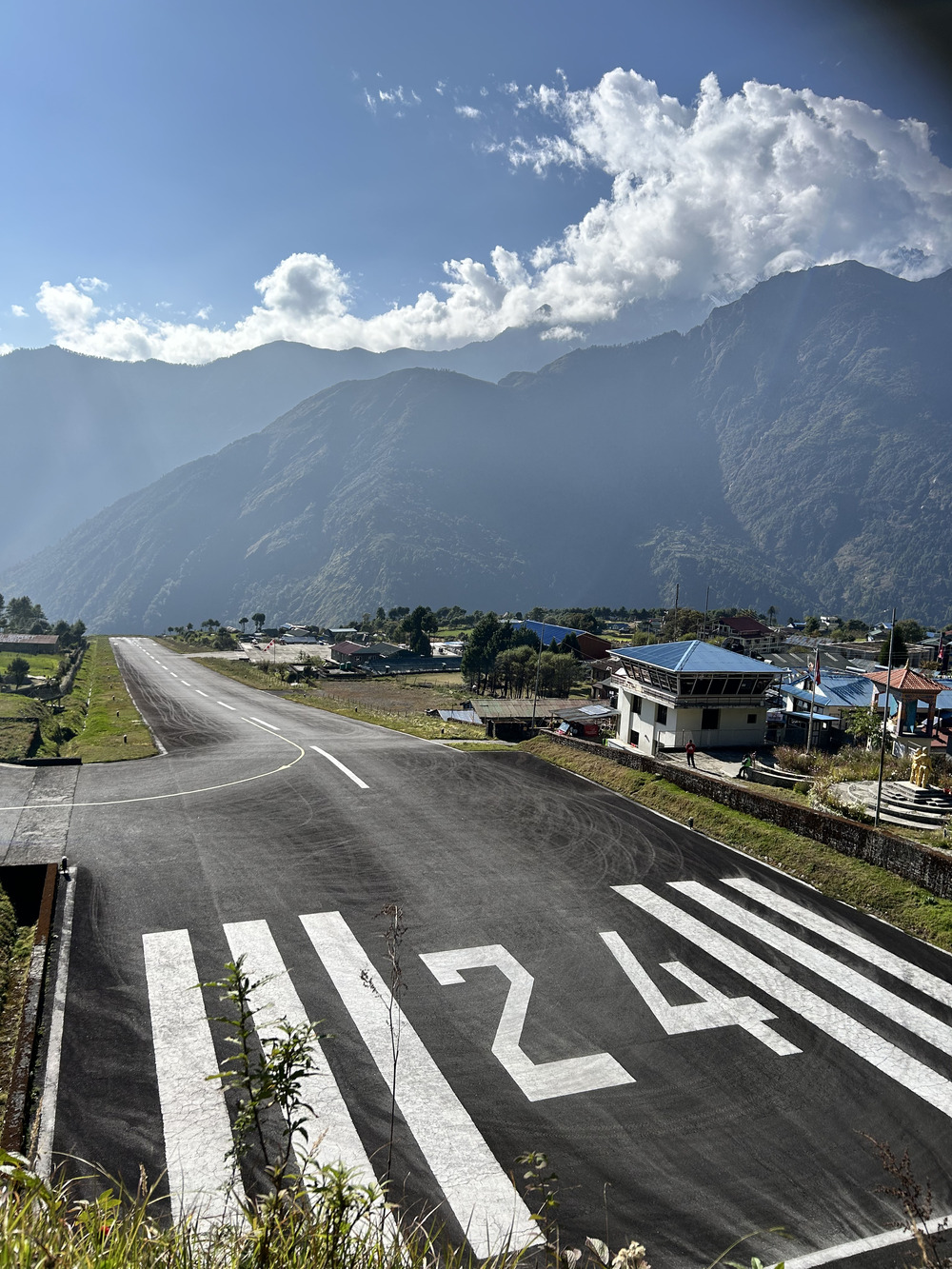
Pradip Bashyal, a BBC journalist based in Kathmandu and writer of the brilliant book “Sherpa” shares his thoughts on the airport that is “considered one of the most dangerous airfields in the world”– Lukla:
“The runway at this airport, which is a brief strip of just 527m (1,729ft) starting at the edge of a cliff on your approach, does not have any overshoot facility. Because of this, even when there is a strong wind, no visibility or any other obstacles on the runway, once an airplane crosses the ‘No Go’ zone, it’s only ‘Go Go’, with no chance of turning back. Pilots therefore claim that sometimes the survival rule in this airport is that you must be skilled enough to break the rules and improvise.”
Lukla airport has captured the imagination of the world as many epithets and adjectives have been tethered to it: it was described as “the most bonkers airport” by the developer of Kaspersky, “a passenger’s nightmare”, “most exciting”, “extreme”, “gateway to Mount Everest”, “world’s scariest landing”, and what not by some unpublished and unpublishable writers.
Though the Lukla airport might seem to be scary (and it is, unless you’re going there on a foggy day with no clear views of where you are headed), if you talk to porters and guides who commute to and from Lukla on a regular basis, they’ll let you know that the flight to Lukla is a banality, an everyday occurrence.
Lukla is dominated by Buddhist philosophy and practice. There’s an old (Zen) Buddhist expression known as “wu’shih” pronounced “buji” in Japanese, which roughly translates as “nothing special.” People who fly in and out of Lukla regularly might see parallels between this flight and an old Buddhist poem, which encapsulates the ordinariness of this everyday-ness:
“Misty rain on Mount Lu,
Waves surging at Che-chiang.
When you have not been there,
No rest from the pain of longing.
But you go there and come back—
It was nothing special.
Misty rain on Mount Lu,
Surging waves at Che-chiang.”
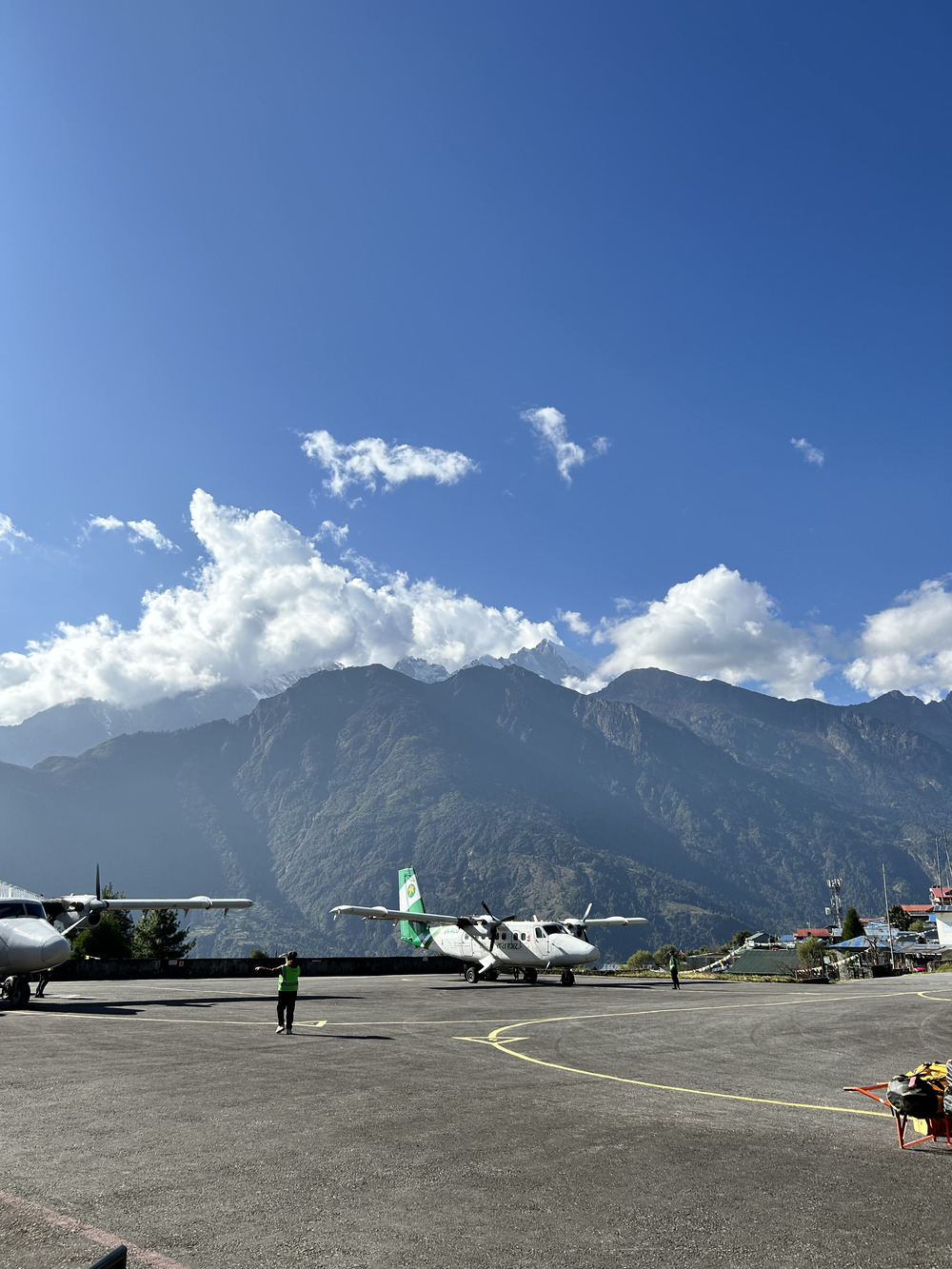

Caught between the extremes of being “nothing-out-of-the-ordinary” and “the most dangerous airport in the world”, where and how do we rank the thrill of the Lukla Airport? Truth, as is often said, falls “somewhere in between”. And the shadow of this airport might, as T.S. Elliot puts it, be tucked:
Between the idea
And the reality
Between the motion
And the act….
Between the desire
And the spasm
Between the potency
And the existence
Between the essence
And the descent
In this article, we’ll delve into the “idea” “the reality”, “the motion”, the “act”, “the emotion”, “the response” and everything in between that makes Lukla an airport that has captured the imagination of travelers and aviationists like very few of the airports have.
1. Lukla Airport is not really the gateway to the Everest region, any more
With the rise of helicopter tourism in the Khumbu region, one might not really call the Lukla Airport a gateway to the Everest region anymore. Helicopters can land directly at Namche Bazaar and beyond. A helicopter has even landed at the top of Mount Everest itself, though normally, helicopters would struggle to get to the top due to aerodynamic and other constraints.


Photo Credit: Airbus
The highest rescue operation in the Everest region was at an altitude of 7800 meters, though the Captain talked about the risks of such operations:
“7,000m is the upper limit of a helicopter’s certification…(The altitude )changes everything. It changes the way we fly, it changes the way the machine flies, it changes all the instruments – there are a lot of things to think about.”
If you are planning for a helicopter tour in the Everest region, chances are that flights will land in Lukla (and other places such as Namche) for refueling. So Lukla, being an aerial gateway to the Everest region, might not be completely mistaken after all. But there are other airports one can land before starting their voyages to Lukla- there’s the Phaplu airport, which can claim to be Lukla’s surrogate of a kind.
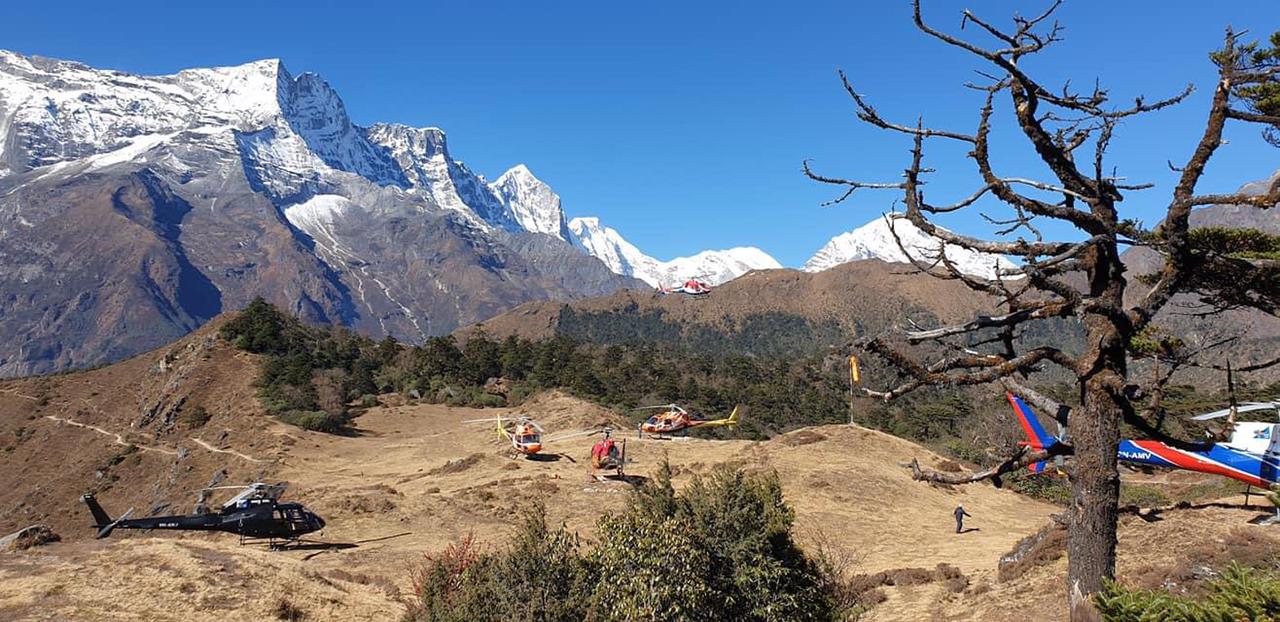

An ever-increasing consciousness of the great amounts of environmental/ecological footprint of air travel has spawned words such as “Flygskam” and “Tagskryt”- both of which are derivatives of a movement aimed at reducing air travel whenever an alternative is feasible. Therefore, we see a lot of travelers getting to Phaplu or Jiri by a (local) bus/jeep to start their trek to the Everest region.
2. The forgotten “most-dangerous airport” in the Everest region, which was tenfold more dangerous than Lukla
Lukla isn’t the exclusive home to an airstrip constructed by Sir Edmund Hillary. This famed mountaineer from New Zealand had also helped carve up an airstrip at an altitude of almost 3000 ft above the Lukla Airport, in a valley known as Mingbo near the Ama Dablam base Camp.
“ So at my request, the Silver Hut wintering group put a team of men on to levelling the site at 15,000 feet, chopping off the frozen clumps of snow grass, filling in the worst of the holes, and rolling away the large boulders. Snow sometimes restricted their activity but it rarely lay for long once the sun was shining again. When the strip had been cleared to 400 yards the first landing was made….Work on the strip continued for some months and we finally enlarged it to 500 yards and generally improved it..”
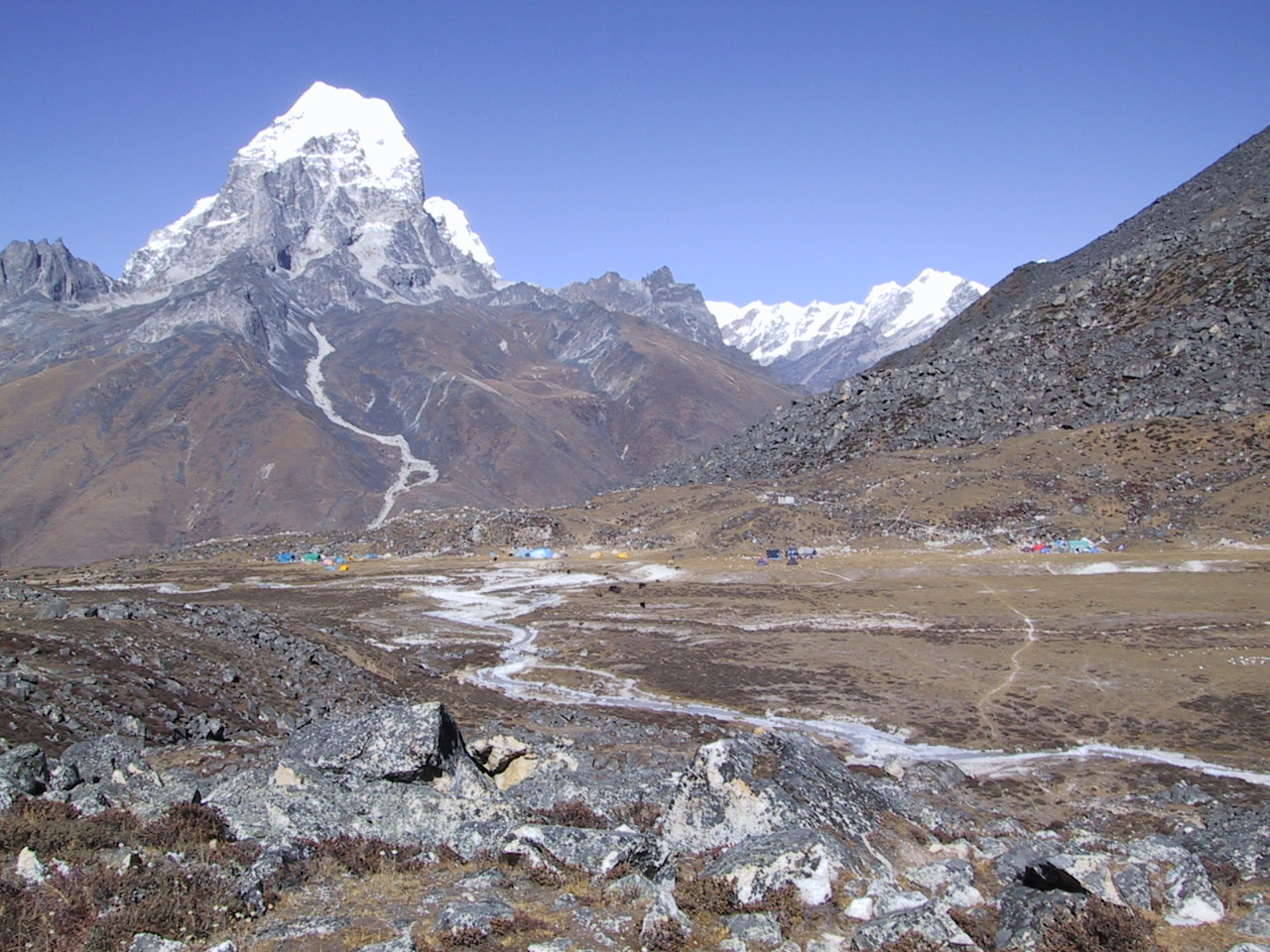

The Mingbo Airstrip
When a Pilatus Porter- the first and the only aircraft to the Mingbo airport- landed near this base of Ama Dablam mountain. its tail wheel was damaged after hitting a rock. To mitigate such damages, the take-off area had to be ridden off of the boulders, which were impervious to attempts at breaking them with sledgehammers. So Sherpas dug enormous holes in the ground next to these giant rocks and then used “long heavy poles as levers” to drive the boulders into the craters. This rendered the airstrip a tad safer. In the words of Sir Ed:
“Altogether we paid $900 for the labour used on building this strip, which possibly made it one of the cheapest as well as one of the highest airfields in the world.”
The Pilatus Porter that landed here supplied necessary items for Tibetans who’d fled their homeland after the Chinese Communists had come to invade Tibet. The aircraft also carried construction materials for the Hillary School in Khumjung. But the Mingbo airstrip wasn’t safe. Neither was it granted permission by the Civil Aviation Authority of Nepal.
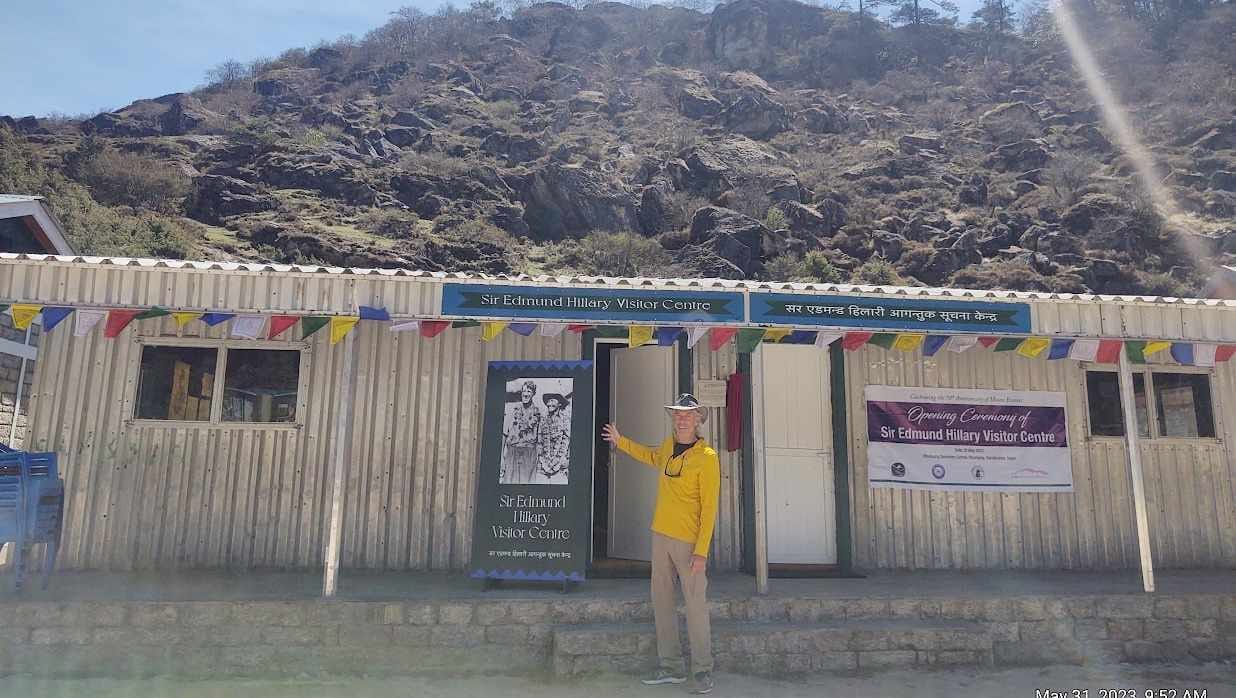

Any aircraft that was to land at Mingbo had to face some of the same difficulties that the captain approaching Lukla Airport would- while braking the aircraft to a halt, one would approach a hill. When personnel from the Civil Aviation Authority of Nepal went with Sir Edmund for a feasibility of the Mingbo airstrip, the weather wasn’t a forgiving one, for there were gusts of wind blowing.
“ It was quite turbulent as we made our approach towards the hill at the bottom of the Mingbo runway. As Captain Schrieber headed down there was a fierce sideways gust of wind and the aircraft started sliding towards the left- hand edge of the field. Captain Schrieber’s reaction was immediate – he just dropped the aircraft from thirty feet to land with a huge thud and then rolled upwards close to the rocks on the left-hand side where we stopped safely at the top. We were all severely shaken. The Civil Aviation gentleman staggered out of the aircraft and vomited noisily. “
The person from CAAN demanded that the airstrip be closed immediately. After reflecting that without a flight from this most dangerous airstrip, it would take him 17 days to get to Kathmandu, he let this airport operate for the last time.
3. The Nepalese government didn’t build the Lukla Airport- Hillary did
The Nepalese government didn’t really have the foresight to build the Tenzing Hillary Airport. The fact that Tribhuvan International Airport in this country once had, albeit with some discomfiture, the peculiarity of being the only airport with a single runway gives you a sense of how the leaders and government officials in the nation don’t quite have the resolve of carrying the aviation of the nation forward.
The leaders’ lack of vision has been highlighted in some thrusts to build Nijhgardh Airport, the construction of which will desecrate millions of trees (in the Nijhgarh forest) in this climatically most vulnerable nations. And this is in a nation where international airports such as Pokhara and Gautam Buddha hardly see any passengers, which might make them catch up with the numbers of the emptiest airports in the world.
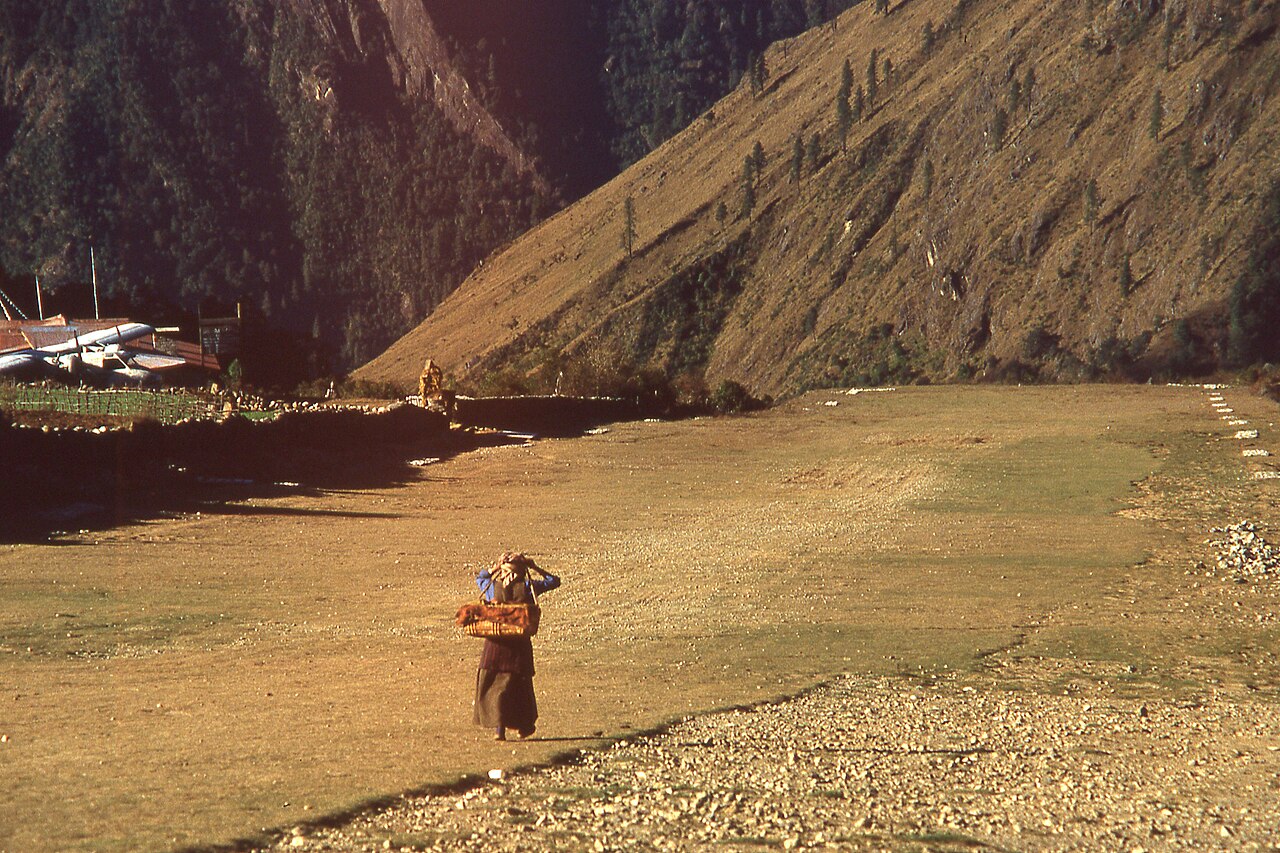

Photo: BBLBobby | Wikimedia Commons
Sir Edmund, along with the locals of Lukla, alone made the effort to build the Lukla Airport. Unlike what has been reported in much of the internet-blog-literature that people in Lukla were unwilling to give up arable land in this region for an airport, Sir Hillary has a different story about the whole saga:
“ I had noticed that below Chaunrikarka there was a large area of almost flat land pushing out into a curve of the Dudh Kosi. I asked Jim Wilson to investigate it and he reported that it just might do, but that it was barely long enough and also very fertile land, so that the local people might be understandably reluctant to sell. “
It was the very people of Lukla who came up to Sir Edmund and suggested a piece of land for the construction of the airport:
“ He was approached by a group of farmers from the small village of Lukla, which was located in a small tributary valley at 9,000 feet. They had some land for sale and thought it would be suitable for an airfield. They even suggested that the wind always blew in the right direction! How hill people who knew nothing about airfields could possibly make this sort of judgement I do not know, but when we went up to Lukla we agreed that they were right. And best of all we wouldn’t be destroying a lot of arable land.”


Photo: BBLBobby | Wikimedia Commons
But the land suggested for the airstrip was way more wayward than it looks right now as it was a veritable juncture of terraced potato fields, heavy scrub, and rough pasture. Hillary, “on behalf of the Nepalese government” personally paid $635 for this piece of land which, in his own words, was ‘substantial’.. More than a hundred Sherpas, with their khukuris and mattocks, worked to clear away the bushes and dig up some land. Sir Ed had even bought liquor for the local Sherpas to get them into the mood for a traditional dance that involved foot-stomping- all with the intention of leveling up land.
“We purchased large quantities of chang* and then employed fifty Sherpas to link arms and stamp their way backwards and forwards across the field. A very festive mood prevailed and the earth received a most resounding thumping. Two days of this rather reduced the Sherpas’ enthusiasm for the dance but produced a firm and smooth surface for our airfield. The strip was 1,150 feet long and 100 feet wide and was clearly marked by white painted boards. Altogether I had paid out just over $2,000 for land and labour. “
*chang= local liquor
Lukla Airport was built in 1962, official flights to the airport began in 1971, and the runway was concretized three decades later.
4. Lukla Airport has been a boon and a curse to people in the Khumbu region
If you go to villages such as Khumjung—one of Sir Edmund Hillary’s more beloved places in the Khumbu region—you’ll find that students who’ve completed Grade 10 don’t want to stay in the village. The only people you will find are schoolchildren or their parents. In recent times, we’ve seen villages of Nepal empty out. This is a trend not simply in the Himalayas of the Everest region but also in the Himalayas of India, Bhutan and other nations.
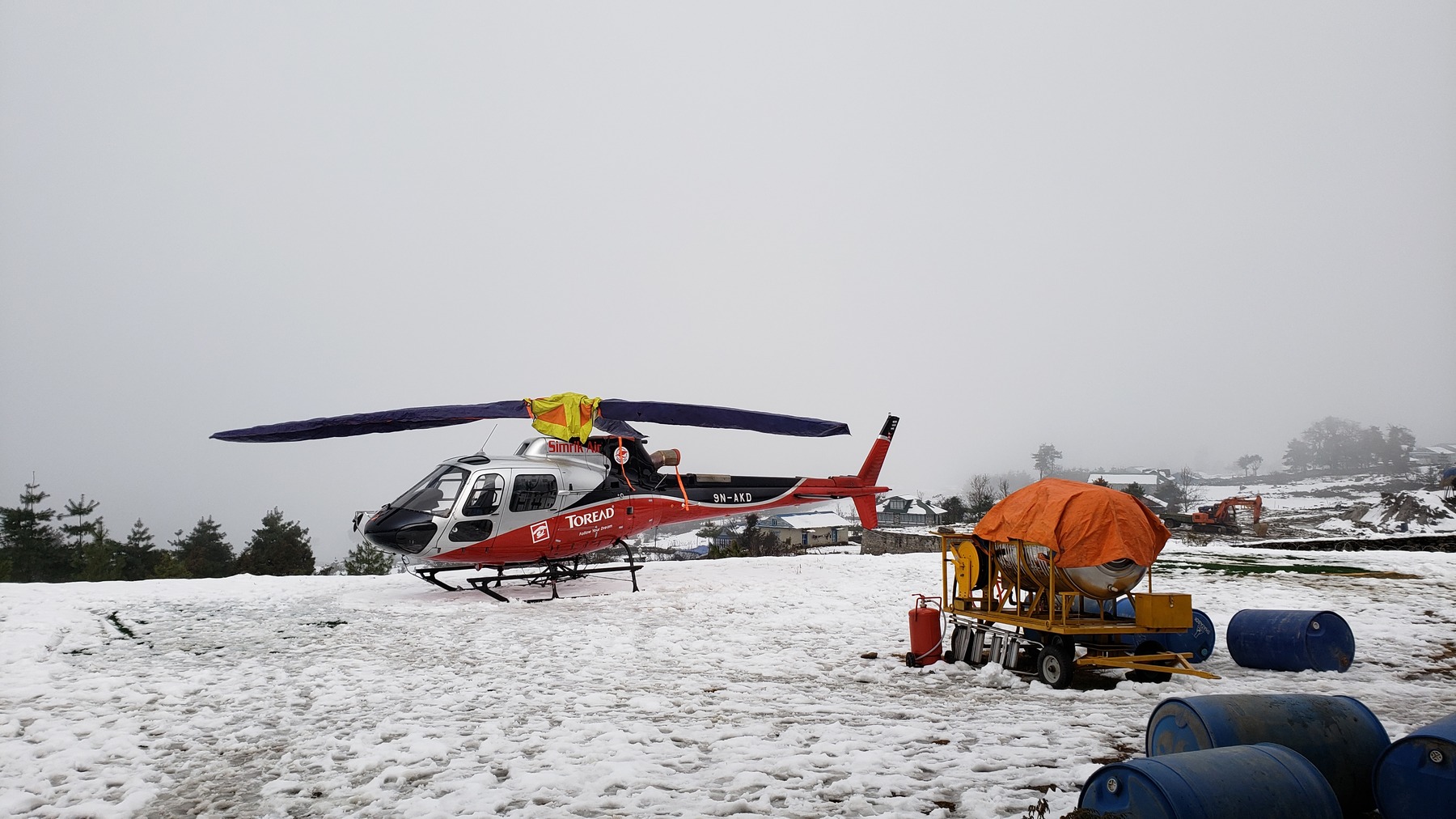

Photo: Surendra Paudel, a helicopter pilot in Simrik Air
Shirley Blair, the director of Shree Mangal Dvip Boarding School: Education for Himalayan Children” was visibly saddened by this trend of “villages being emptied out of all the abled-bodied ones”
“The mums with small children and the elderly ones are staying…..Makes me sad…..We encourage children to stay. Many children go abroad because they want to help their parents, and I understand that.. But I see culture getting lost. Who’s there to take the transmission of the knowledge? And there’s so much rich knowledge in Nepal, of culture, not just in the mountains. That makes me feel sad.”
While tourism has made many Sherpas involved in tourism/ mountaineering economically well-off than they were before Hillary constructed the airport, it has also resulted in the breaking of the fabric of the traditional society of the region and brought about environmental damage there.
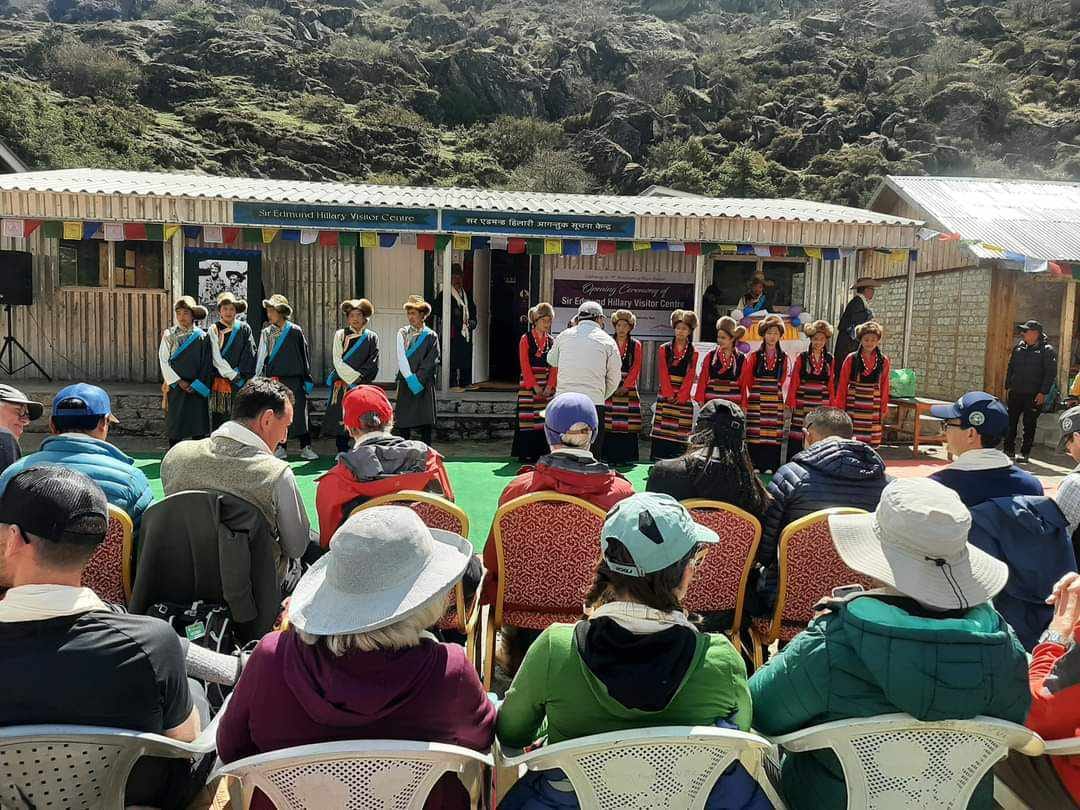

After the airport was built in the region, many travelers have had access to it, and the region’s economy has boomed. But along with these developments have come some very palpable threats to the environment. Snow levels in the Khumbu Valley have depleted over the years. There’s an almost insurmountable problem of oxygen cylinders and trash cans on Mount Everest. To put it in numbers, 12,000 lbs. (5,400 kilograms) of human waste is generated in the Everest region after harmful chemicals and pathogens get mixed into the water supply system during monsoon.
Izabella Koziell, the director of ICIMOD- an organization working for the conservation of the Third Pole, believes that the melting of the glaciers in another of the Himalayan region of Nepal (like Everest)- the Langtang Valley, was likely to affect billions of people who relied on the waters from the mountains.
“I was truly shocked to see how far the glaciers have receded.. I was also shocked at the challenges that the local communities faced…..”
In light of the environmental consequences brought on by traveling in the Himalayas of Nepal, she also opined:
“Tourists need to be aware and pay for the environmental impact…”
Though the melting of the glaciers is a microcosm in the macrocosm of the “global change in weather and climate patterns,” the environmental pollution in the Everest region shows how we need to save it from being overcrowded- like certain places in Italy. Izabella also commended Sagarmatha Pollution Control Center’s wonderful work in light of the limited resources they have to conserve the environment of the Khumbu region.
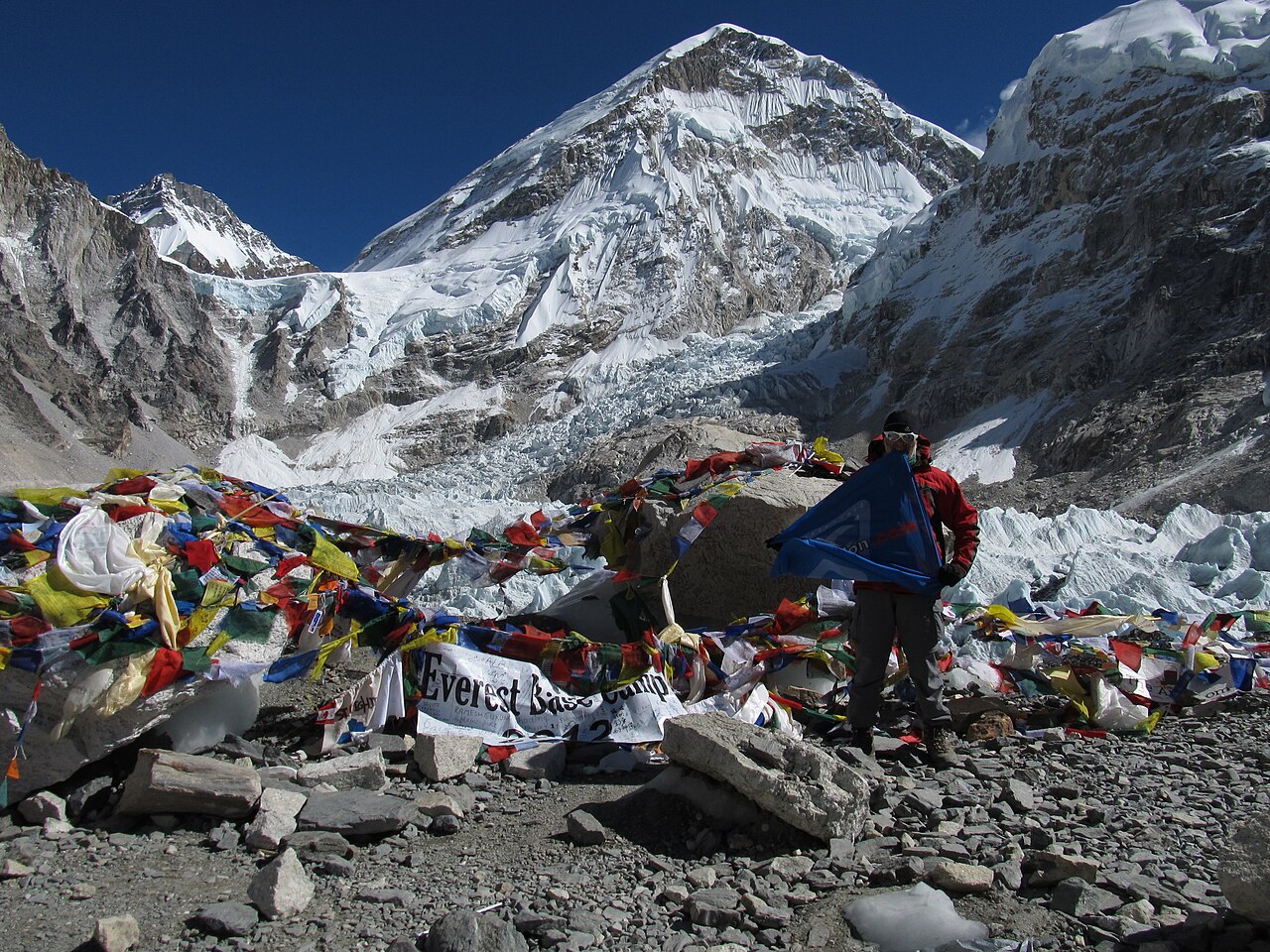

Photo: Robert Kern | Wikimedia Commons
There are bright patches of modernization in the Everest region, too: many schools have been constructed in the Khumbu region as schools have been built in Thame, Khumjung, Pangboche, and Namche Bazaar- all of which are supported by the Himalayan Trust. The Khumbu region also houses hospitals and other health centers, which were non-existent before the construction of the Lukla Airport. Before the construction of modern facilities like the airport, getting essential goods/ medical supplies into Lukla was difficult- something that caused a lot of distress to a lot of people living in the Khumbu region. Sir Edmund Hillary pints at an anecdote to exemplify this:
“ Before we knew her, Ang Doule had had thirteen pregnancies, but only two had resulted in live births, and, of these, one was a complete cretin and the other deaf. All these difficulties were the result of iodine deficiency. Once we got her onto a course of iodine injections she gave birth to two perfectly healthy and normal sons, much to her delight. “
So one shouldn’t be caught between the extremes of the “negativity related to the loss of traditions” in the Everest region as the airport opened it to globalization (or the “horrible impacts of climate change”) and the overt positivity of economic benefits. Buddhism, the religion that is practiced in the region, says that one ought to live a life above and beyond extremes , after all.
5. Politics has killed the alternatives to Lukla Airport
Lukla airport is tucked in a marvel of a district in Nepal- Solukhumbu. The word Solukhumbu can be broken down into two sections: “Solu” and “Khumbu,”- both of these words refer to two different regions within this district in the East of Nepal.
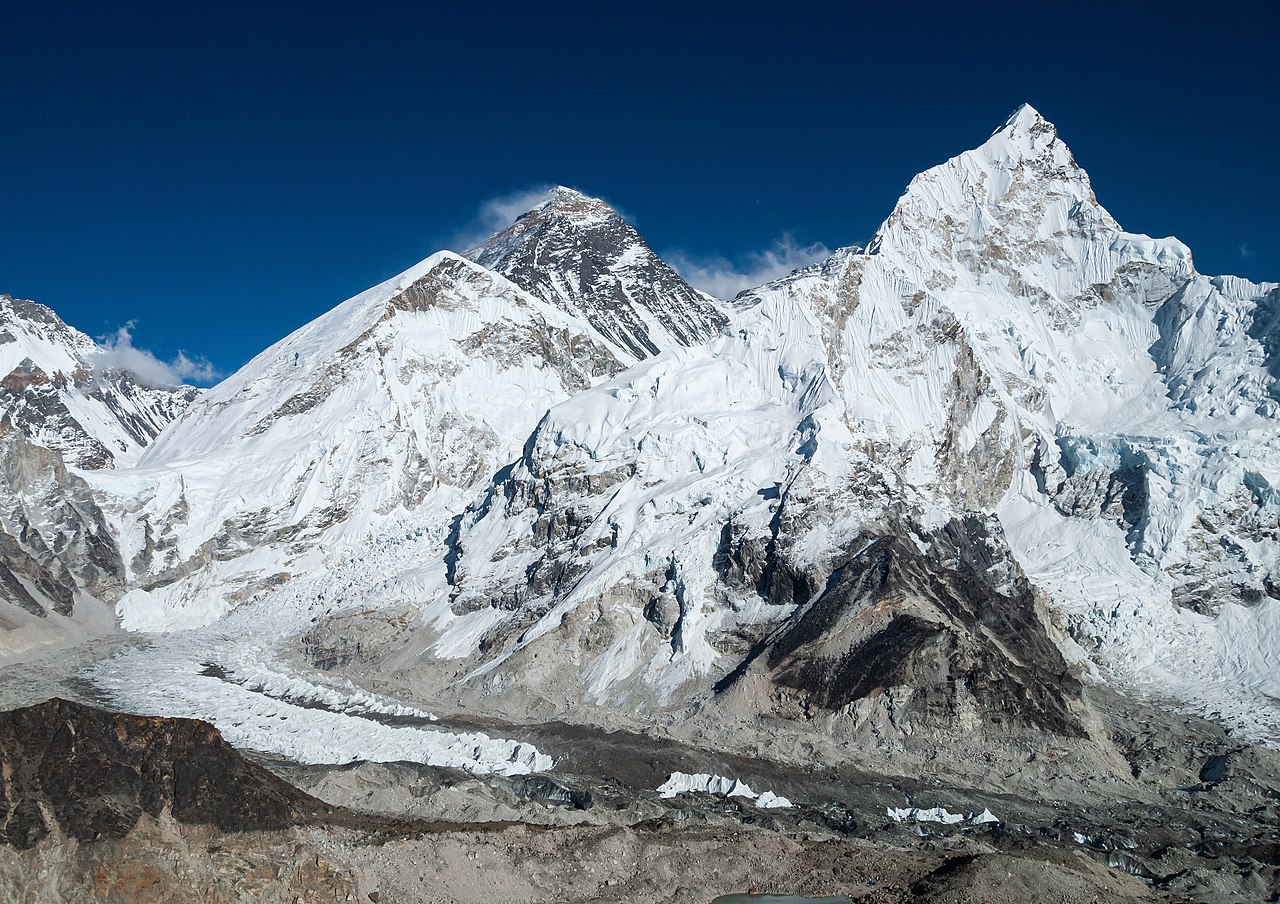

Photo: Vyacheslav Argenberg | Wikimedia Commons
So, although the people who’ve originated outside the district might say they’ve been to Solukhumbu, the locals of the district can be particular as to whether one has been to the “Solu” region or the “Khumbu” region- Khumbu being the one that lies upwards of the Lukla Airport and houses the Everest Base Camp and other great mountains of the Everest region.
There are a total of 4 airports in Solukhumbu- one of them being in the Khumbu region itself.
Syangboche Airport
The highest airport in the Solukhumbu region is Syangboche Airport. It is around two hours walk from the famed village and main marketplace of the Khumbu region – Namche Bazaar. The opening of Syangboche Airport would cut down on the trekking time of roughly two days to get to Namche Bazaar from Lukla Airport.
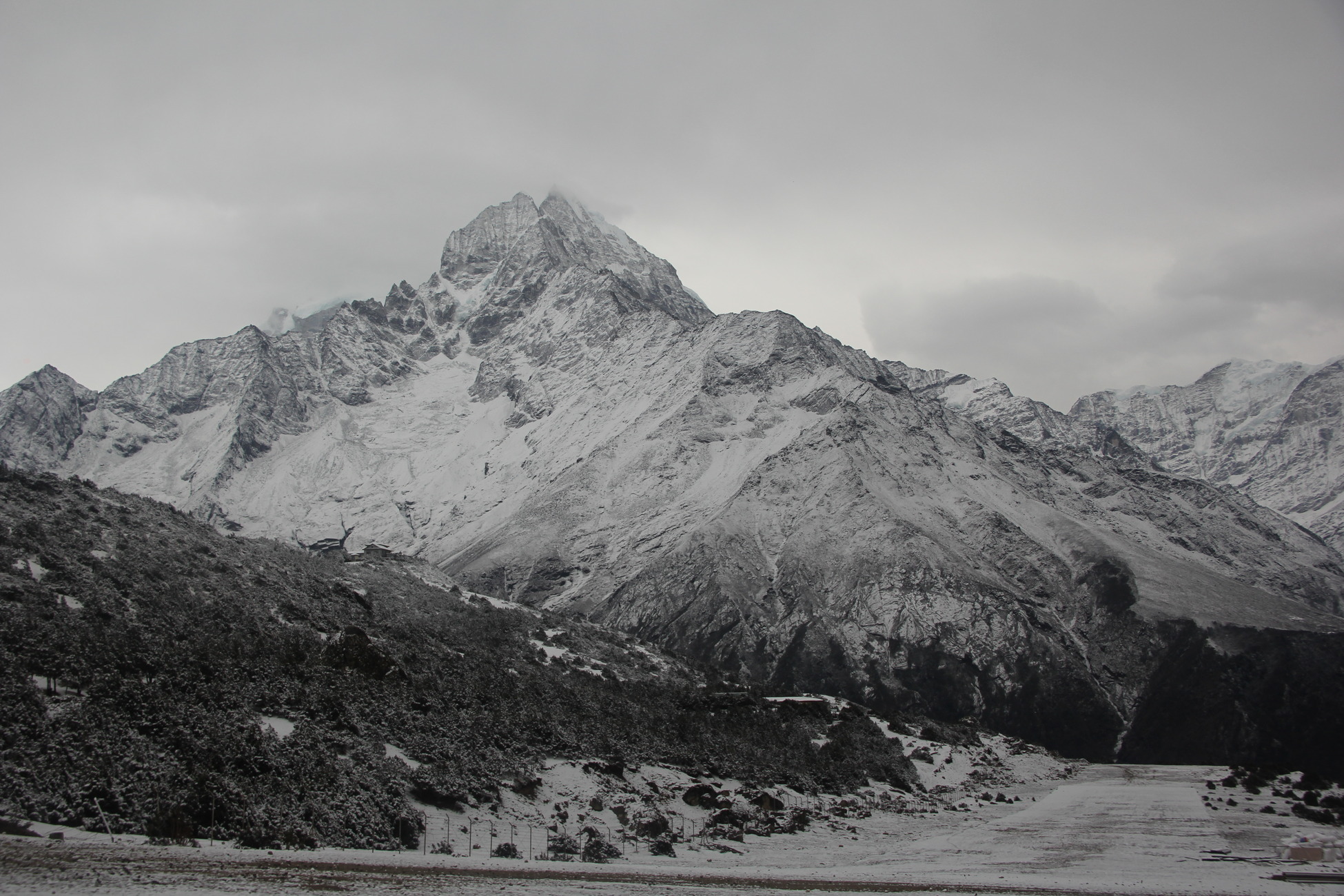

In 1996, locals of Lukla staged a protest against the construction of Syangboche Airport. The owners of lodges placed below Namche feared that tourists would opt to fly to and from Syangboche directly. A hypothetical scenario like that would mean that businesses in villages between Lukla and Namche, such as TokTok or Monjo, would shrivel. This was well-documented by Nepali Times, which chose to call the row over the construction of the Syangboche an “air war over Lukla.”
However, the non-functioning of this airport is not simply down to politics. In a report of 12 years of flight in the Everest region compiled by the retired captain of Royal Nepalese Airlines, Emil J. Wick, and Edwad E. Hindman of The City College, New York, they reported instances of a “funneling effect” that allowed the Pilatus Porter operating in the region to soar above the ceiling altitude of the aircraft:
“Thc flight pattern followed the valleys, which were usually ncarly calm, until reaching Syaogboche airfield. There, a transition occurred to the high speed westerly airflows. As a result of the high-speed flows, two wake turbulence regions were often encountered. The first region was downwind (east) of Taboche peak and the second was downward (east) of the Chakri ridge. T avoid these regions, the plane flew underneath the wakes. ”
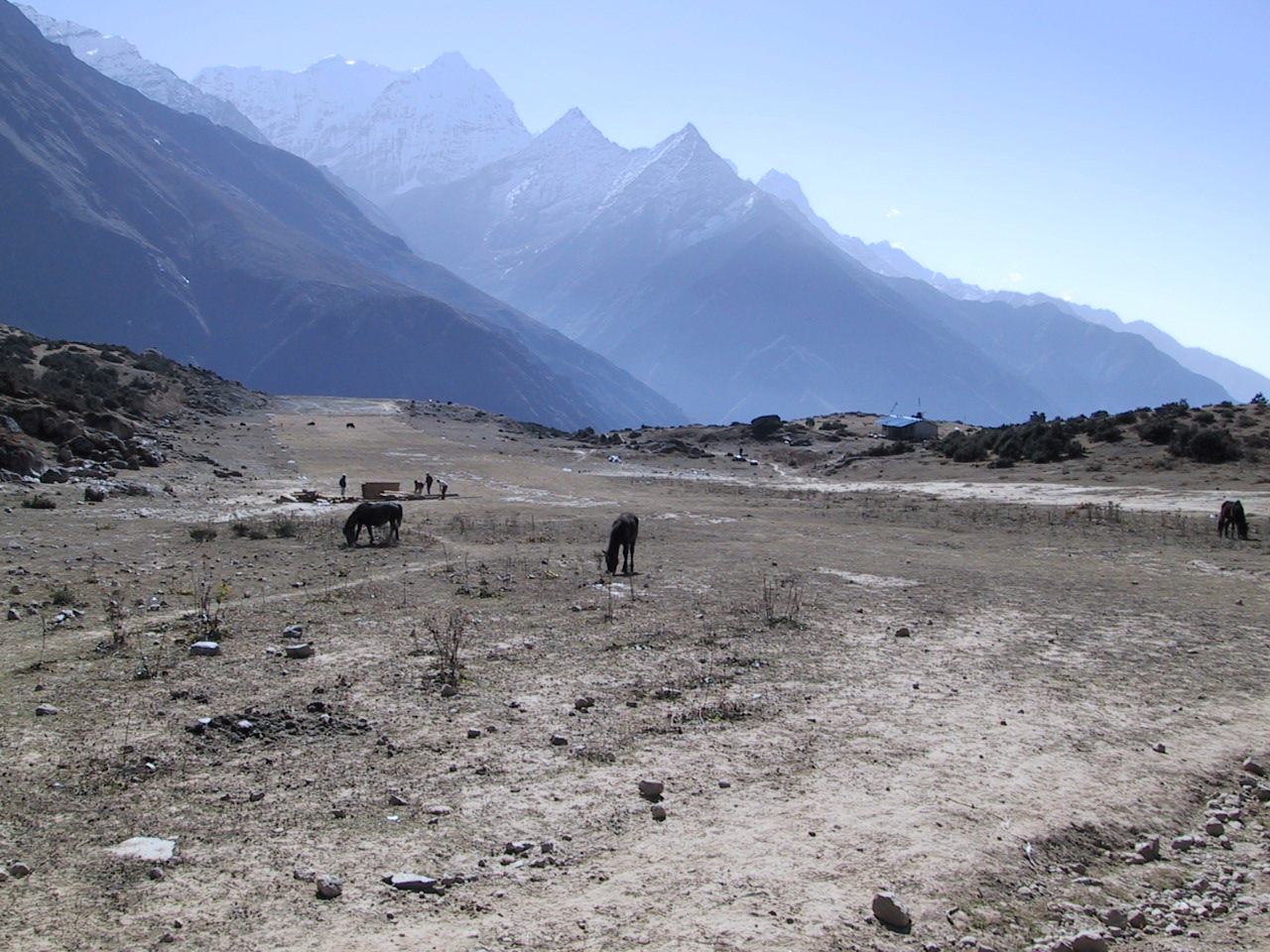

Photo: Ivan G. Somlai
A brief summary of the airports in Lukla
| Airport | Altitude | Runway Dimension (lxb) | Apron type | Type of Runway |
| Syangboche | 3748 m./12293 ft | 405 m x 30 m | Earthen | Earthen |
| Lukla | 2846 m/ 9334 ft | 527m x 30 m | Bituminous Paved (Asphalt Concrete) | Bituminous Paved (Asphalt Concrete) |
| Phaplu | 2468 m. /8097 ft | 680 m x 20 m | Bituminous Paved (Asphalt Concrete) | Asphalt concrete |
| Kangeldanda | 2097 m/6880 ft | 520 m x 26 m | Earthen | Earthen |
Phaplu Airport
Phaplu Airport is a resort for people who trek to the Everest Base Camp in what is known as the “Classic Route,” which involves getting a feel of some of the trails that Sir Hillary took to climb all the way up to celebrityhood. After all, before his efforts to construct the Lukla Airport, he had to walk his way to Lukla (and Khumbu).
If a flight en route to Lukla can’t land at the supposed “most dangerous” airport in the world, pilots sometimes resort to landing at Phaplu Airport. This STOLport can claim to be the only alternative to Lukla. Phaplu and Lukla are separated by a mere 10 minutes (on average) of flight time. But if you were to take a hike from Phaplu, you would need almost 4 days to get to Lukla.
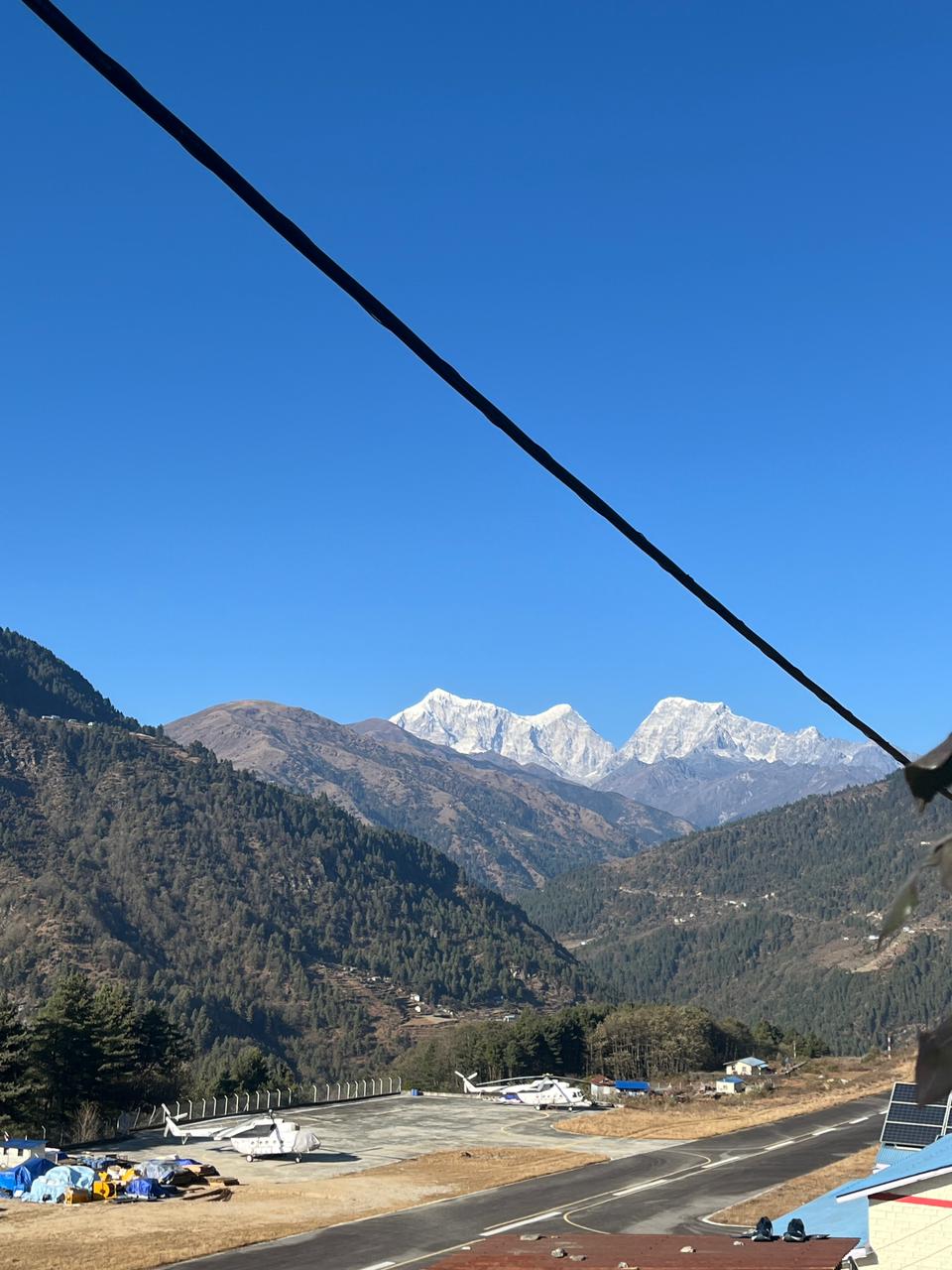

Photo: Pasang Chhiki Sherpa
Phaplu Airport is thought to be predominantly a freighter airport. Goods (from Kathmandu and other parts) are transported here by flight. From then on, they are loaded onto mules and yaks and transported all the way to Lukla and beyond. This method of transportation, as opposed to air-transport, can make goods in the Khumbu region cheaper.
Sir Edmund Hillary’s wife lost her life during the crash of a flight from Kathmandu to Phaplu Airport. The investigation of the Pilatus PC-6 Porter and was piloted by Peter Shand revealed the critical role of the “Remove Before Flight” that is used in aircraft. Sir Edmund Hillary reflected on this issue in his book, “View from the Summit”.
“To ensure that parked planes don’t shift about or flip over in strong winds, locking pins labelled with long red tags were inserted in the flaps. Due to a simple oversight, one of the pins had not been removed before take-off, turning the aircraft into a flying bomb. The plane had risen briefly into the air before plummeting into a paddy field just beyond the airport. The resulting explosion blew out windows in the control tower.”


Photo: Rucksackschule-dresden | Wikimedia Commons
Kangeldanda Airport
In a long list of unattended, uncared-for airports in Nepal lies the Kangeldanda Airport in Solukhumbu. Like the Lukla airport, it is perched atop a hill, but it doesn’t have the same walled structure that airplanes landing in Lukla glare towards while taking to a halt. It is more or less open-ended.


With this airport turning out to be a veritable grazing field for cattle, the airport probably has no future, it doesn’t have a present. And whatever little past had was mired in swashbuckling corruption. Govinda Raj Pokharel, a former deputy chair of the National Planning Commission, was quoted in the Kathmandu Post to have commented about the throng of abandoned airports, like Kangeldanda, in the country:
“State coffers are being emptied in the name of air infrastructure to meet populist agendas….Leaders’ announcements of airport construction please people as they assume that would bring about development. But these airports that cannot even raise their own operating costs are a scam.”
6. Lukla doesn’t have as nightmarish a history as one might think
“Is the Lukla Airport safe?” This is the question that everyone who has heard of the airport or is looking to get to it ponders over. There’s always what the Germans call a hintergedanken, a thought at the back of your mind, about the possibility of one perishing during this flight. Given that aircraft flying from Nepal are banned from getting into the territory of the European Union and the fact that this country was blacklisted by IACO, too, the safety of a Lukla flight is everyone’s primary concern.
But despite such concerns, Lukla doesn’t have a terrible safety record for an airport dubbed “the most dangerous”. Two of the biggest crashes for a flight to/from Lukla, in terms of fatalities, were conducted by Yeti Airlines and Sita Air.
Sita Air 2012 crash
On 28th September 2012, a Dornier 228-202 operated by Sita Air took off from Kathmandu Airport but minutes after take-off, the aircraft wanted to perform an emergency landing in TIA. But the aircraft crashed, killing all 19 onboard.
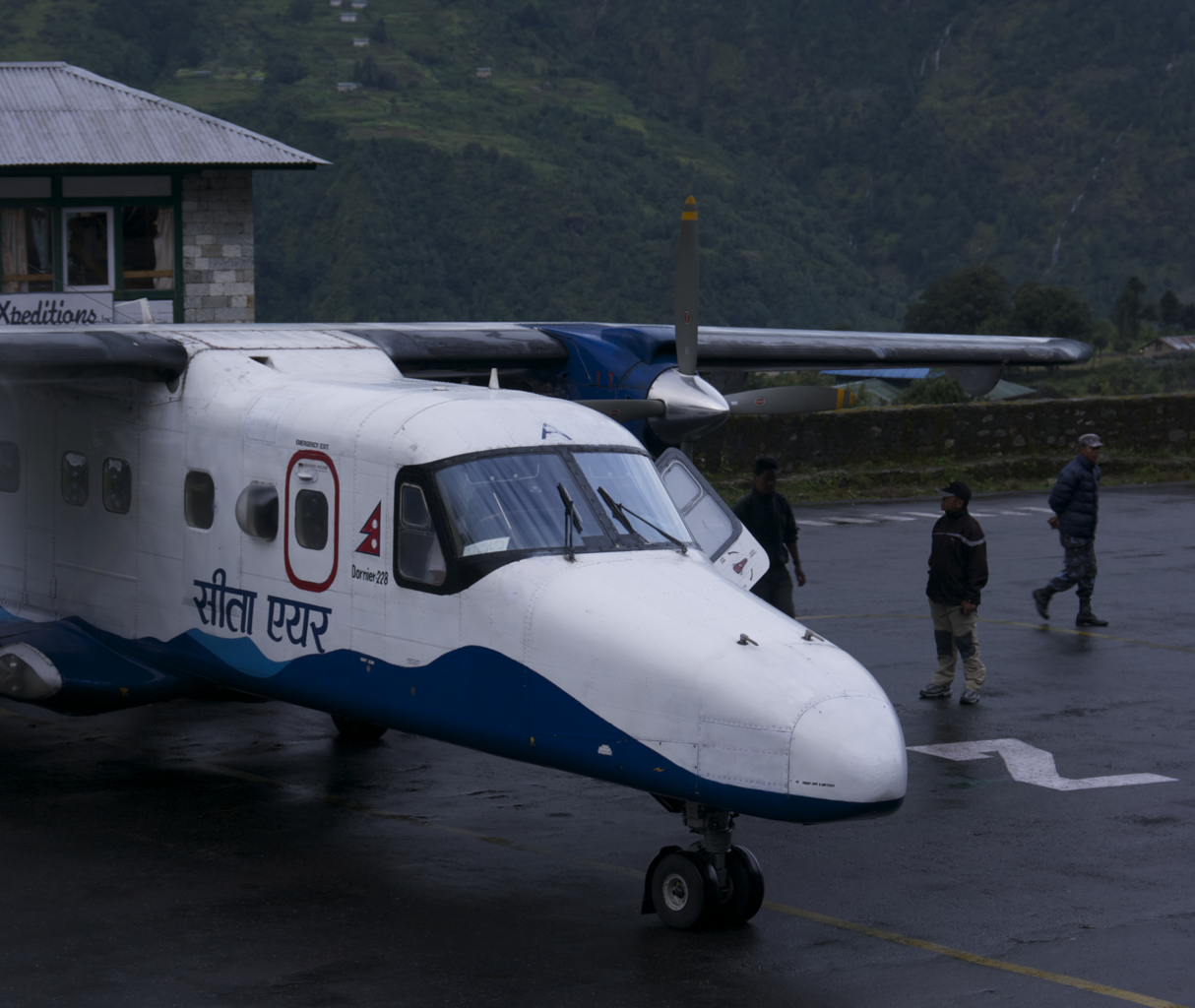

Photo: Brendan Hickey | Wikimedia Commons
License:
The investigation quoted the following as “Causal Factors for the Crash”
“ 1. During level flight phase of the aircraft, the drag on the aircraft was greater than the power available and the aircraft decelerated. That resulted in excessive drag in such a critical phase of ascent lowering the required thrust. The investigation was unable to determine the reason for the reduced thrust.
2. The flight crew did not maintain the airspeed above the stall speed, and there was insufficient height available to recover when the aircraft departed controlled flight. “
So, the deadliest crash according to Lukla had nothing to do with the geographical terrain or other factors that made Lukla the most dangerous in the world.
Yeti Airlines Flight 101 crash
In 2008, when a Yeti Airlines’ De Havilland Canada DHC-6 Twin Otter Series 300 registered as 9N-AFE attempted to land in the Tenzing Hillary Airport, all the passengers and one crew of the aircraft were killed- the only survivor, a pilot, who, following the incident, had to be ushered into a psychiatric ward.
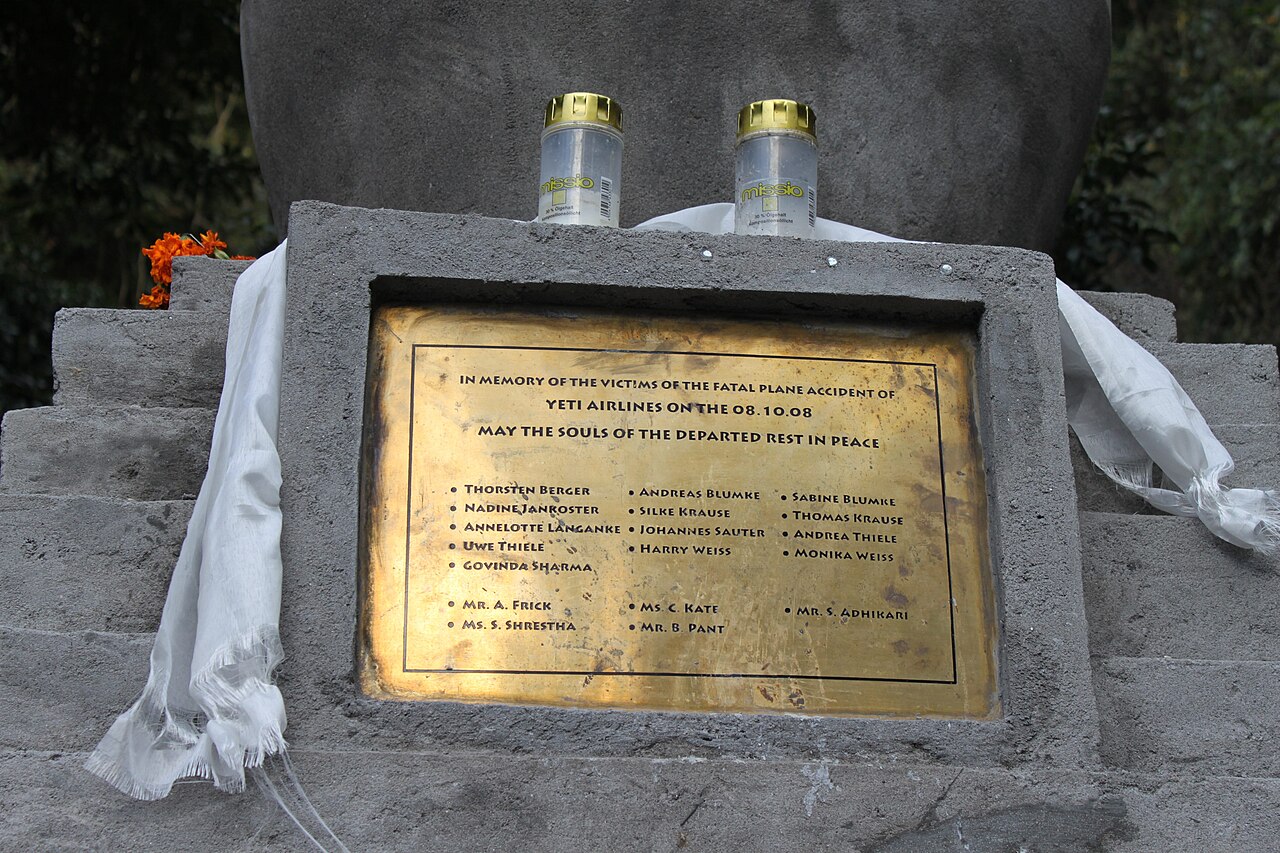

Photo: Superikonoskop | Wikimedia Commons
The investigation report of this crash pointed fingers at the flight crew’s misinterpretation of how fast the weather would deteriorate over the skies of the Lukla Airport. and their expectation of a cloud patch on final approach, which had been reported by previous flights landing in Lukla.
The report also pointed at the following reasons as “contributing factors”:
“ a) Failure on the part of the regulatory body and company safety management to check the wrong practices being followed by pilots especially in STOL airfields like Lukla on a timely basis.
b) AFIS personnel on duty not being able to declare airport closure due to high workload, stress and landing of preceding three aircraft in similar marginal weather conditions.
c) Operator (Yeti Airlines)’s priority of economical aspect over safety such as their unequal treatments between pilots landing in adverse weather and diverters, creating a ‘Must Land’ situation.”
Other Notable Crashes in the Lukla region
It might be ironic that though a paved runway and an asphalt apron might be a symbol of state-of-the-art airports, it was only after Lukla Airport’s airstrip was pitched that the airport saw fatality in the planes that crashed there. The notable accidents that took place in Lukla prior to the turn of the millennium such as a Royal Nepal Airlines DHC-6 Twin Otter 300 crash on 15 October 1973, a Royal Air Nepal Harbin Yunshuji Y-12-II crash on 26 September 1992, a Nepal Airlines DHC-6 Twin Otter 300 (registration 9N-ABA) crash on 9 June 1991- all involved damage to the aircraft but no fatalities.
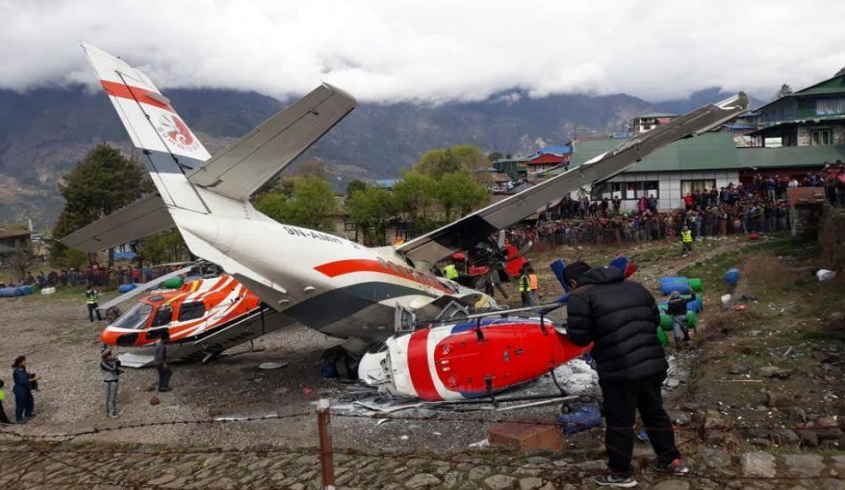

Photo: Government of Nepal
Aircraft Accident Investigation Commission, 2019
Helicopter Crashes in and around the Lukla Airport
In 2019, a Summit Air Let L-410 Turbolet aircraft (registered 9N-AMH) attempting to land in the Lukla airport collided with a Manang Air Eurocopter AS 350B3e helicopter (registered 9N-ALC) on the helipad of the airport. 3 people- one of whom was the co-pilot of the plane and two police officers on the ground were killed.
In 2023, a helicopter operated by Manang Air crashed after taking off to Kathmandu from Lukla. Five Mexican tourists and a nepali pilot were killed in this accident that took place.
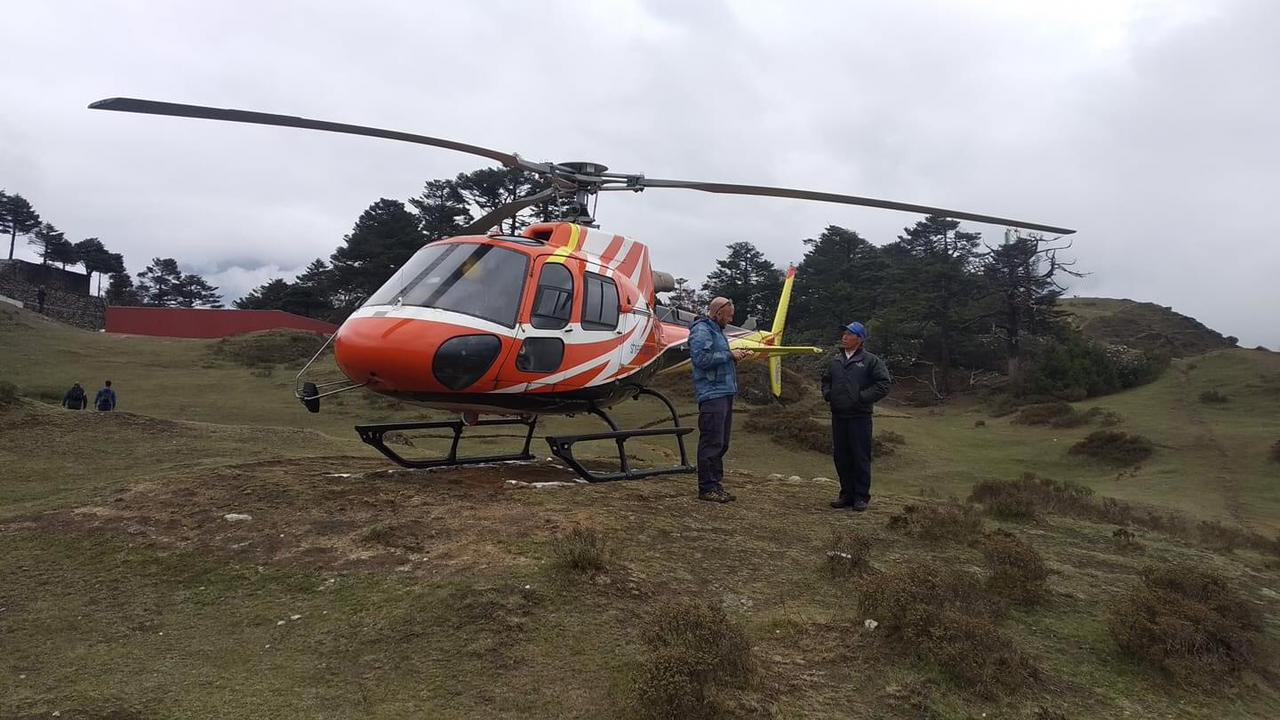

Apart from these crashes, a couple of accidents have taken the lives of people who were aboard or operating planes to Lukla. All in all, data from Aviation Safety Network reveals that approximately 50 people have been killed in crashes involving flights to and from Lukla. One might say that for an airport that is dubbed to be the most dangerous in the world and has been operating for close to 60 years, the fatality count is not as high as it appears on the outset.
7. Lukla Airport is(not) really an airport? STOLport or altiport or aerodrome?
Lukla Airport’s dimensions are so small that it wouldn’t be able to accommodate some of the world’s largest planes ever built, let alone these aircraft taking off or landing. The biggest aircraft in the world- the Scaled Composites Stratolaunch has a wingspan of 117 meters- the Hillary Airport is merely 30 meters wide. The world’s largest commercial aircraft – the Airbus A380 is able to land only in the airports that are categorized into Group VI mandated by FAA. Airbus A380’s wingspan is two and a half times greater than Lukla’s breadth.
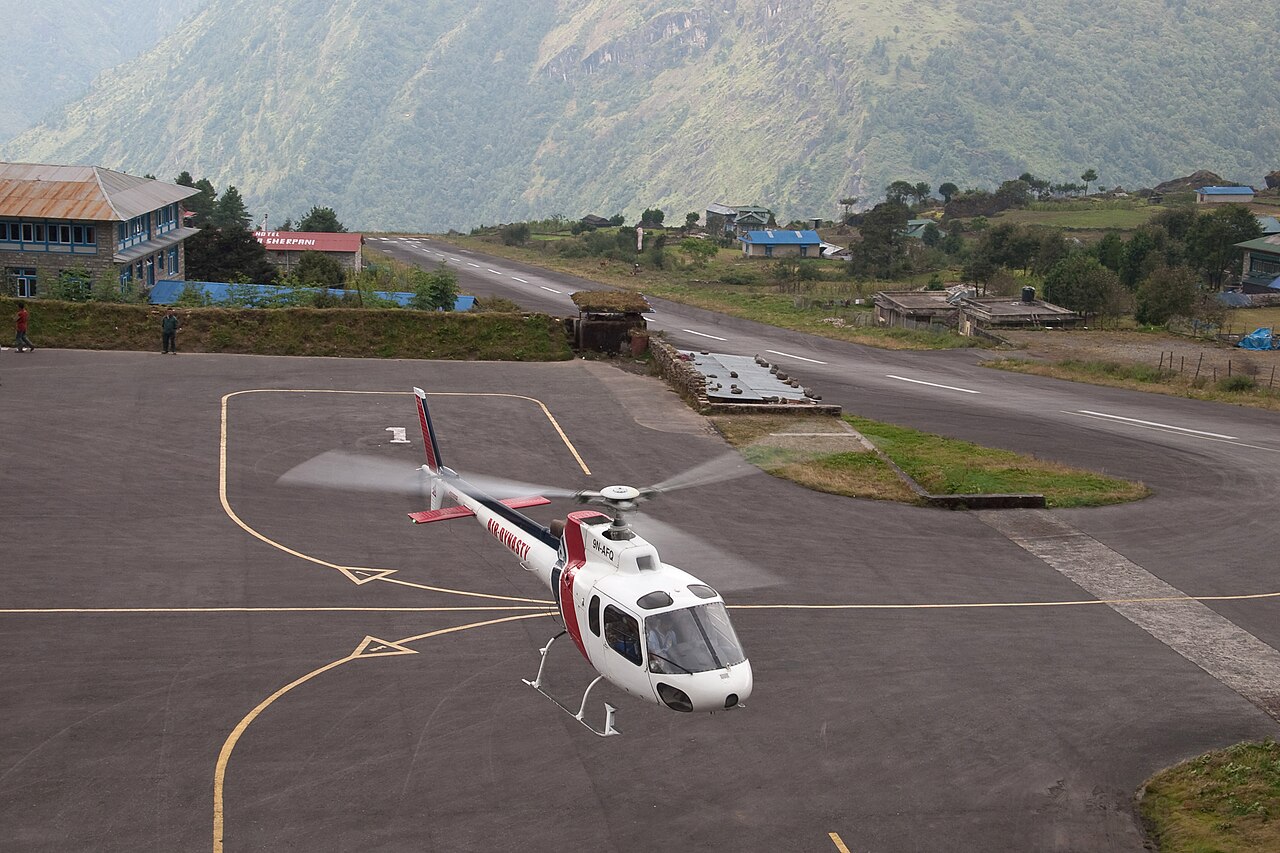

Photo: Vyacheslav Argenberg | Wikimedia Commons
So would we really call “Lukla” airport, an airport to begin with? There is a strong faction of the aviation community which believes that the word “airport” would not be applicable to Lukla- one should be specific and call it a “STOLport”. ICAO defines what STOLports are: “unique airports designed to serve airplanes that have exceptional short-field performance capabilities.” The STOLport manual of ICAO also says that “for the purposes of this manual, the stolport design aeroplane is assumed to be an aeroplane that has a reference field length of 800 m or less”.
ICAO recommends the use of the term Lukla Altiport would be the best formal way to put it into words, as it defines an altiport as:
“a small airport in a mountainous area with a steep gradient runway, used for landing up the slope and for take-off down the slope, thereby making use of only one approach/departure area.”
So calling Lukla an airport might not be wrong but calling it a STOLport would be more precise- much like calling the highjacking of an aircraft “skyjacking”.
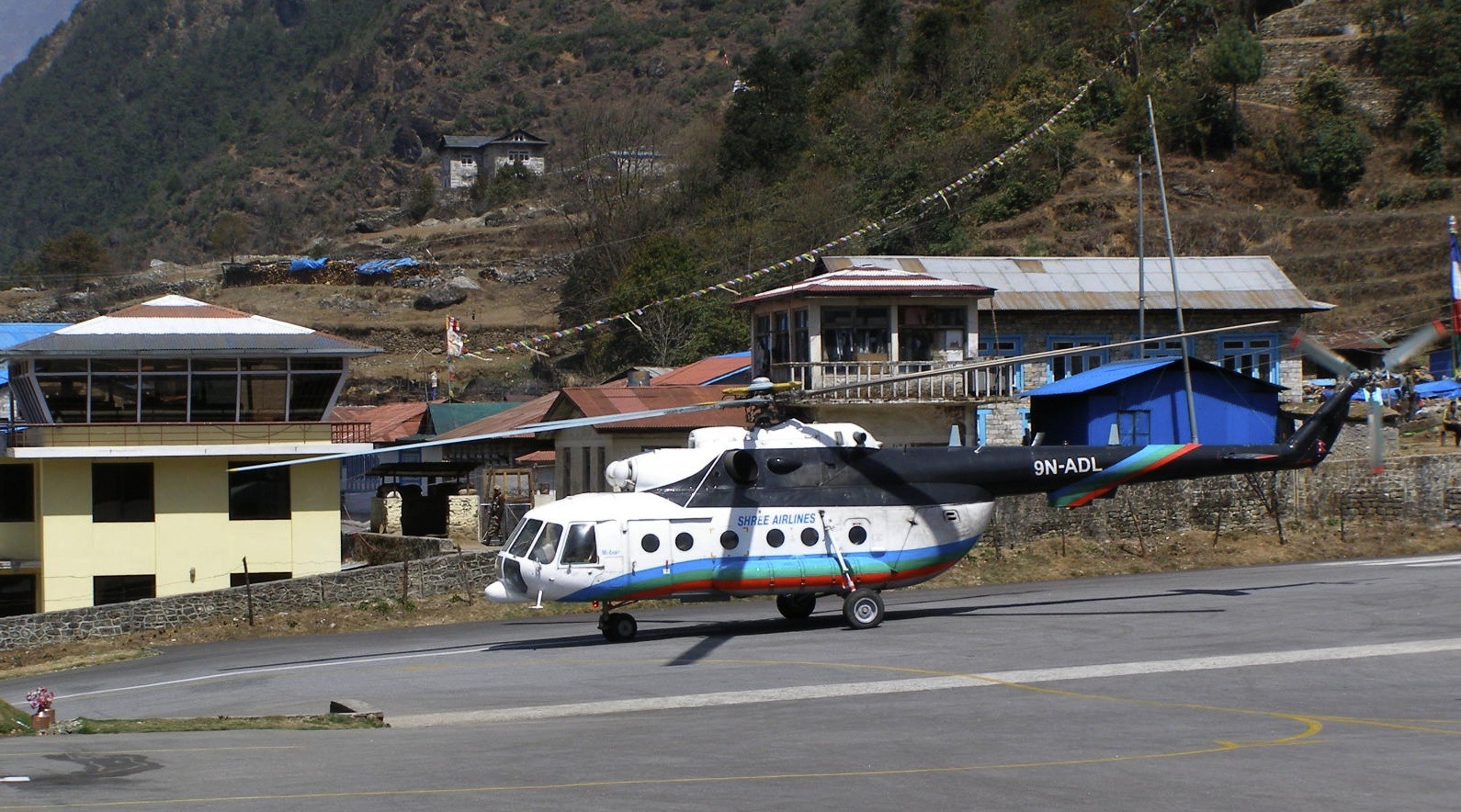

Photo: Bsk77 | Wikimedia Commons
Alternatively, one can also call Lukla’s airport, an aerodrome. There’s some consensus in the aviation world that an “aerodrome” which meets certain standards can be called an airport, thereby the maxim “all airports are aerodromes but not all aerodromes are airports”. But “aerodrome” is not as popular a word in North America as this term is perceived to be exclusive to Commonwealth Nations. But the criteria of which aerodromes can be upgraded to become airports might be different in different nations.
So someone might, depending upon their nations’ aviation standards, call Lukla airport, the Lukla Aerodrome and still be right.
8. Most dangerous airport and other myths
One of the top results for a Google search for the keyword “Lukla Flight Diversion” lands you at a page whose screenshot is below:


The “writer” clearly says that there’s an instrument landing system (ILS) in Lukla when there’s no such arrangement in any of the airports in Nepal. Most travel blogs operated in Nepal are written by people who’ve never been to any of the destinations they are reporting about. Aviation journalism has received a lot of flak in the country, and with pieces like the screenshot above, there’s very little “authentic” information one is likely to find.
Ashish Niraula, the operator of the Radiant Treks, shared some of the difficulties of finding the correct information about aviation/ travel in the nation:
“Most of the travel blogs that rank on Google’s first page are written by writers who have not been there. So, while writing they write what they find on the source. But it’s not like there is no correct information on the web. We should be able to find the right source. For example, while taking permit information, I suggest taking a reference from TAAN or another government official tourism website. Similarly, if you want to know about a place or a trekking trail/place, I suggest reading a travel blogger who actually goes there and writes about their experience and information on their blog.”
Some of the world’s largest aviation websites are accused of being involved in “churnalism” and “content farming” instead of journalism. So in light of such a state of affairs, that Lukla has been shrouded by a lot of myth-making shouldn’t surprise anyone.
Terms such as “the most beautiful,” “the most dangerous,” “the most wonderful” or “the scariest” etc can be quite subjective. The idea that Lukla Airport is “the most dangerous” stems from dubbing the airport as the most dangerous for more than 20 years by the History Channel.
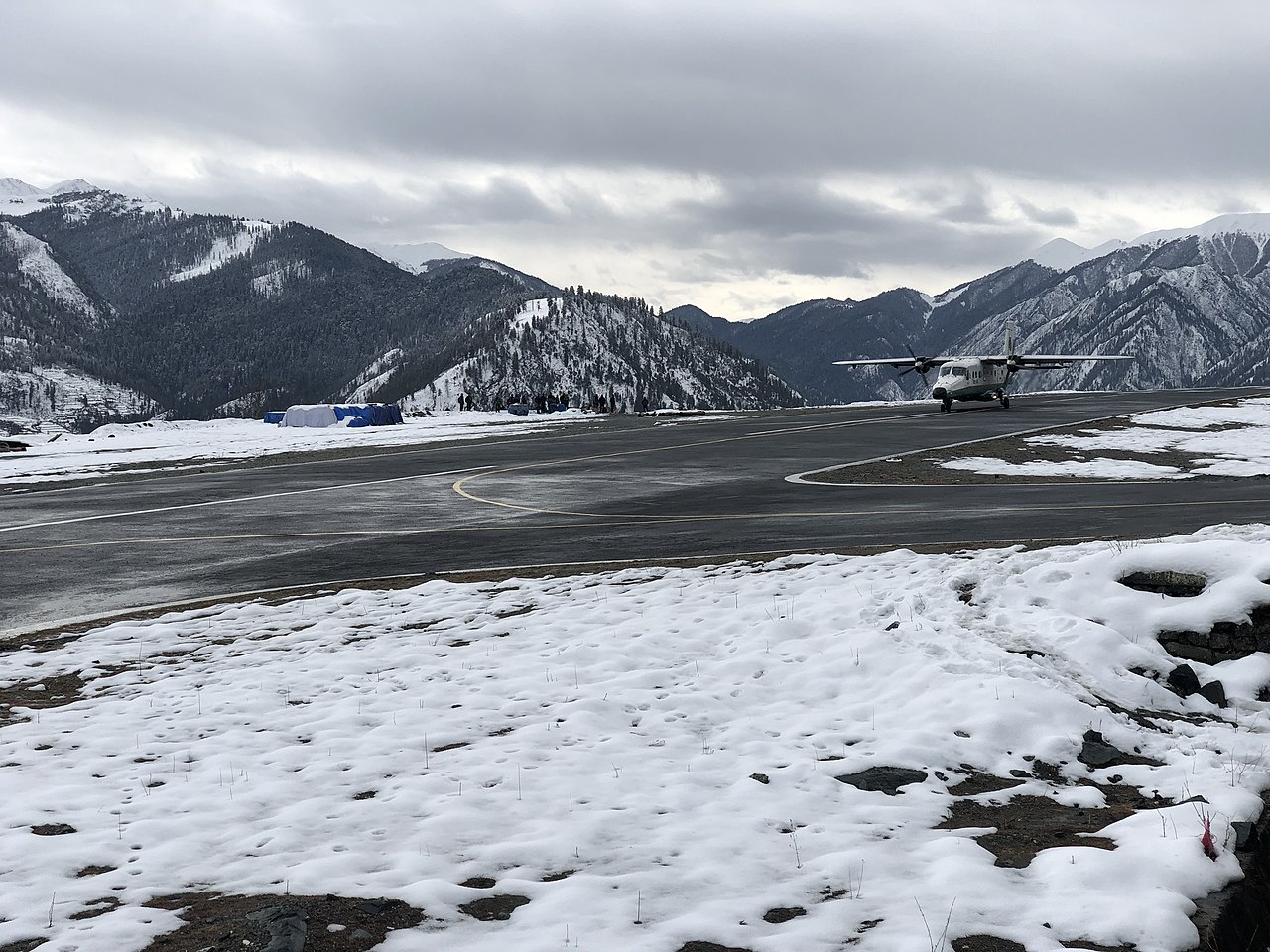

Photo: Tannu 01 | Wikimedia Commons
Many aviation professionals in Nepal don’t consider the Lukla Airport/STOLport/altiport/aerodrome to be the most dangerous in Nepal, let alone the world. Ujjwal Tiwari, an Air Traffic Controller, who has served two of the more beautiful ALTIports in Nepal- Simikot and Lukla- shared his opinion about the “most dangerous-ness of the Lukla Airport”:
“There are other airports too which are more challenging than Lukla, Talcha (also known as Rara airport), Juphal ( Dolpa airport). These airports have tailwind limitations of 8 knots, which is sometimes reduced to 6 knots depending upon the wind direction and tendency. Having worked in various airports and talked with numerous pilots, they have shared their experiences and challenges and never have I ever found Lukla as being the most challenging or dangerous airport for landing.”
Since the Everest region draws in a lot of money for the Nepalese government (in terms of revenues collected from trekking and mountaineering), Nepal doesn’t often contest the labeling of Lukla Airport as “the most dangerous”.
“ Rara and Dolpa are more vulnerable hence 6-8 knots is also considered riskier. One thing pilots have shared is the crosswind in these two airfields are to be kept in mind and being prepared for go-around at any time during approach. Another thing which might have contributed to the infamous status of the most dangerous airport might be the flow of aircraft and publicity. Lukla being the gateway to Everest, it has received much more publicity than any other airports of Nepal. “
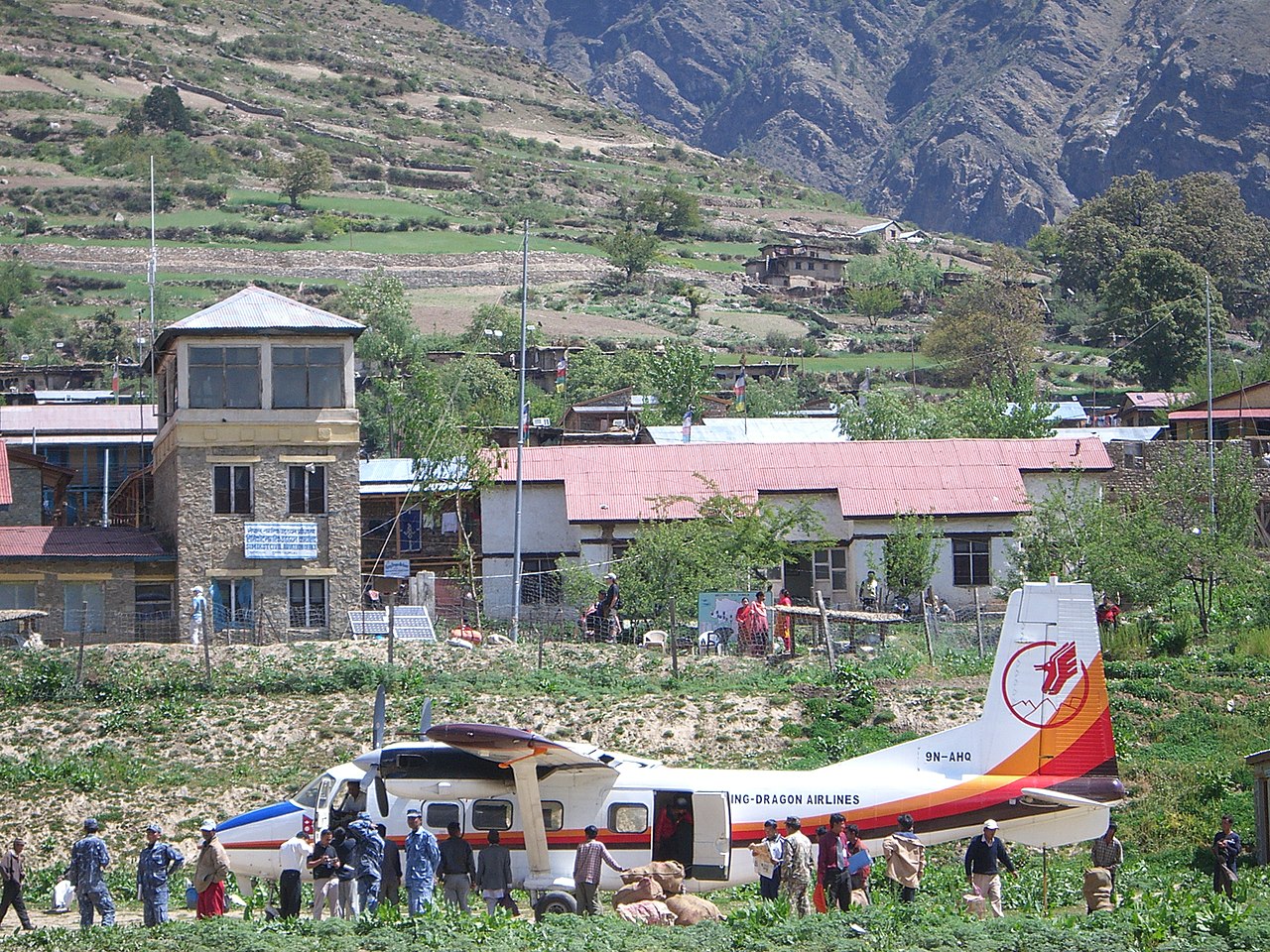

Photo: PilotGiraffe | Wikimedia Commons
For we will never be able to find a pilot who has taken-off from or landed at all the difficult airports to fly into/ out of, carrying out tests about which airport is the “most dangerous” will always be a subjective experience, instead of an objective one.
